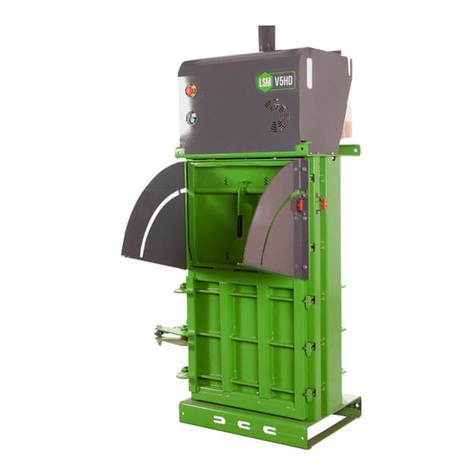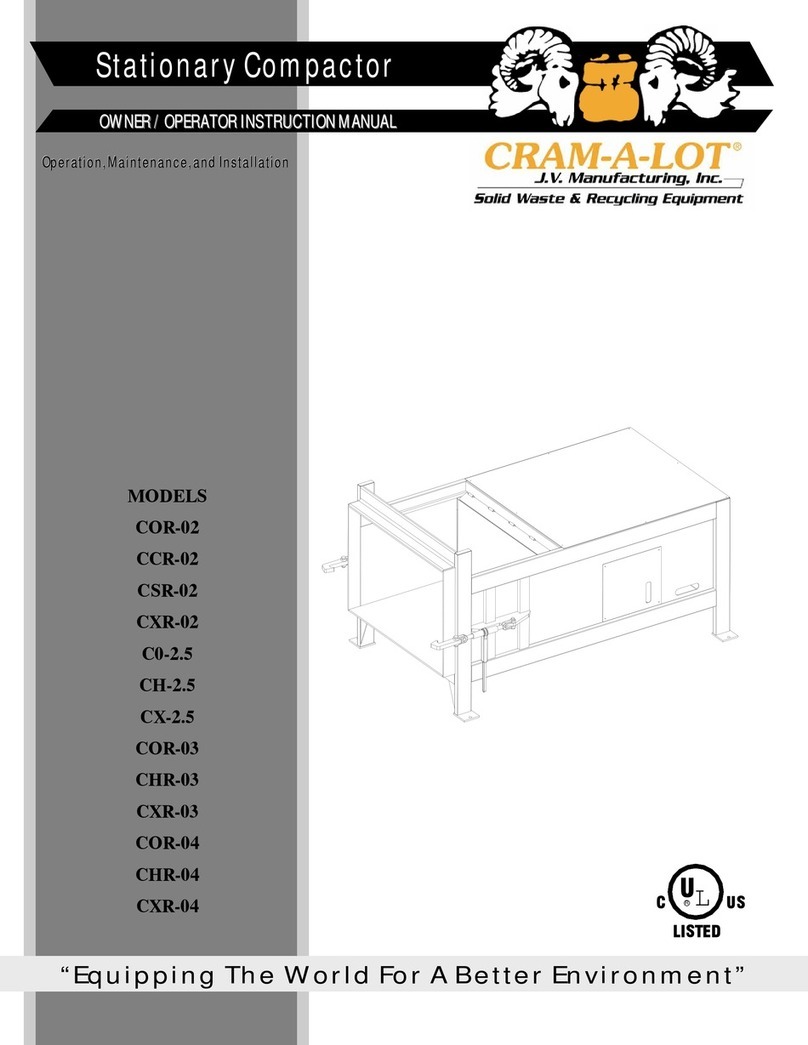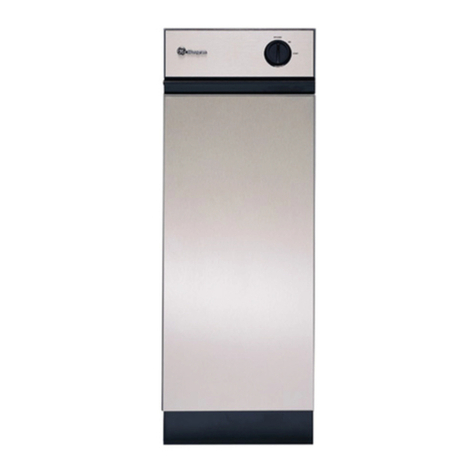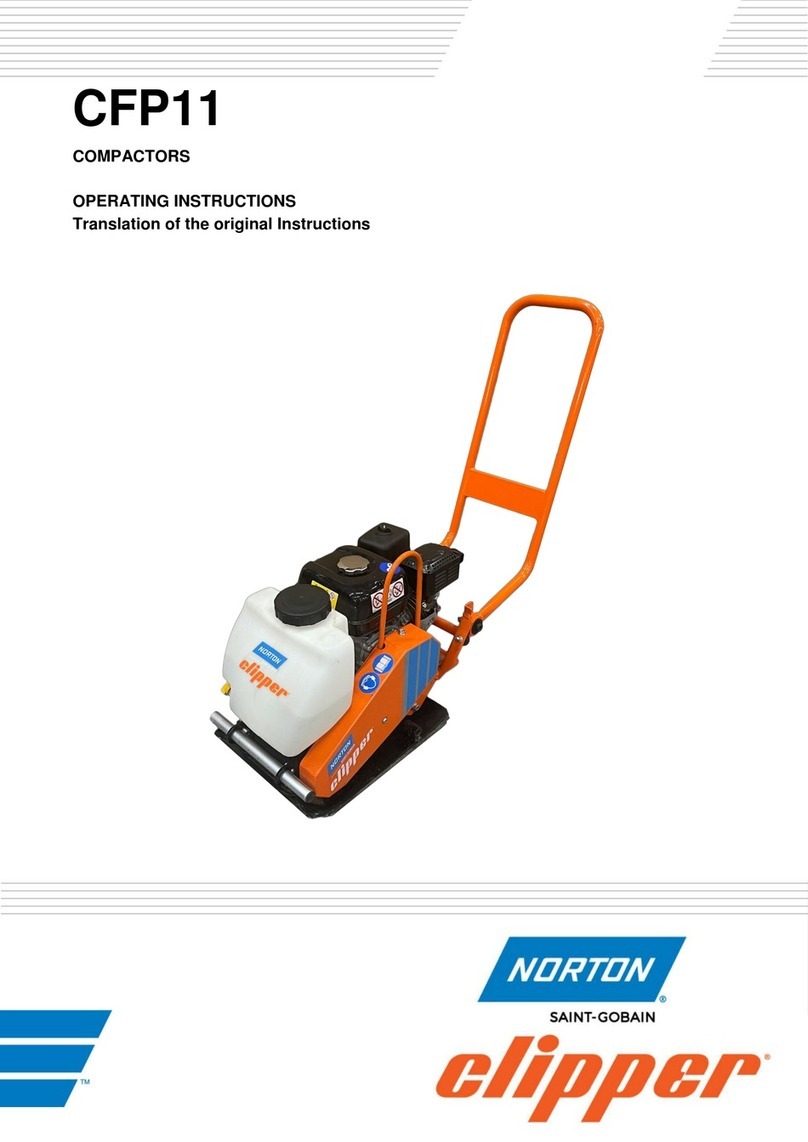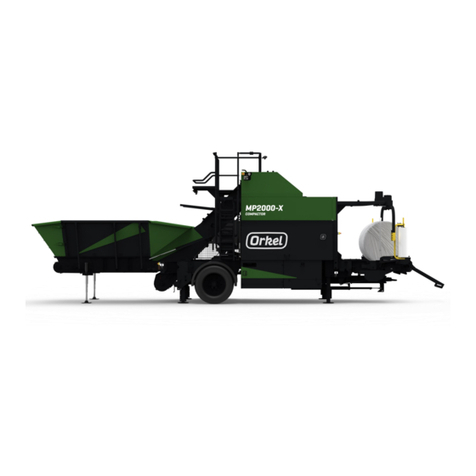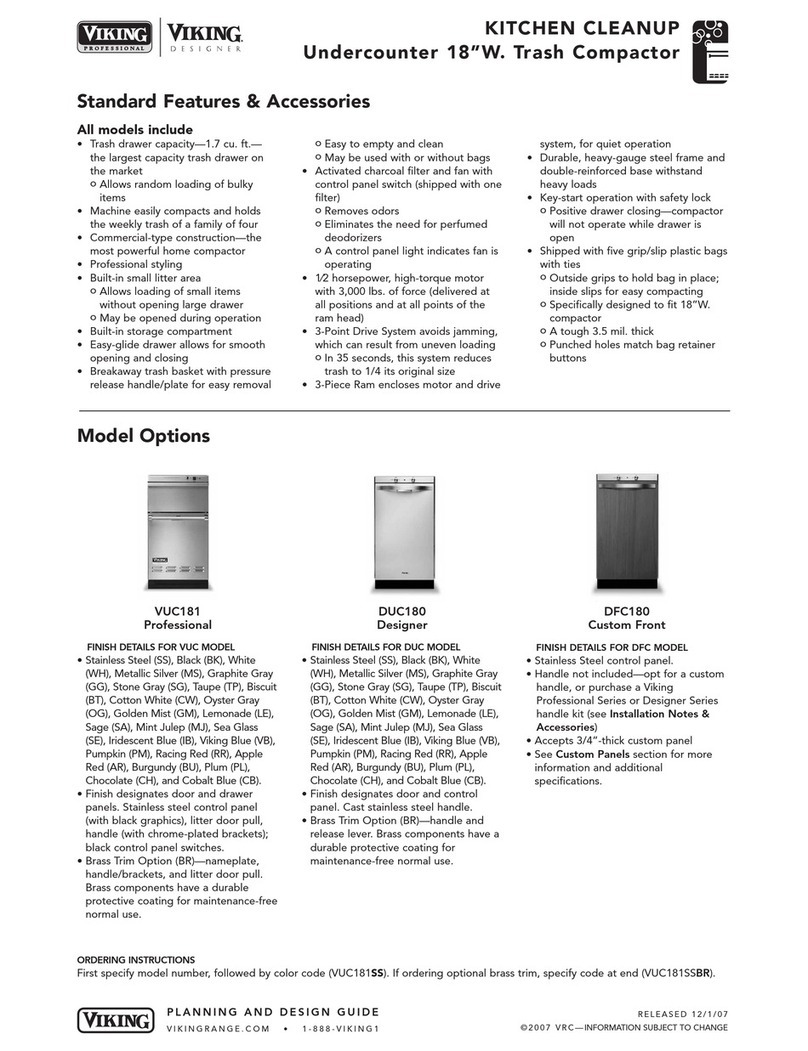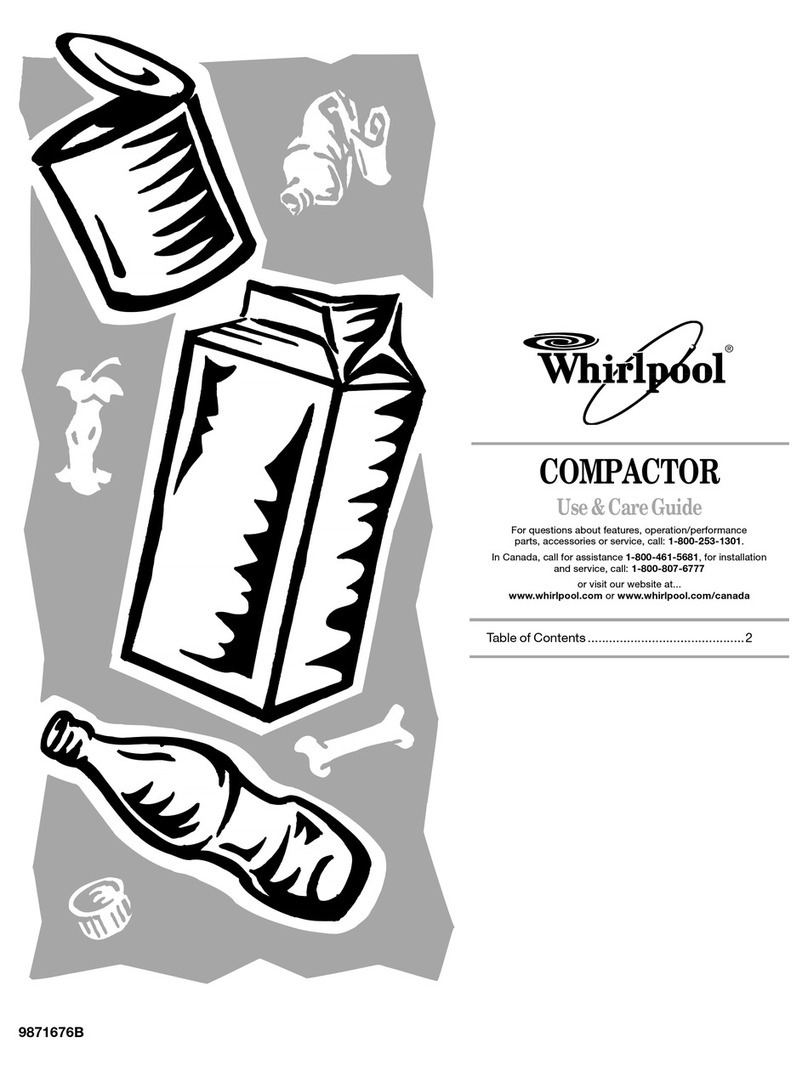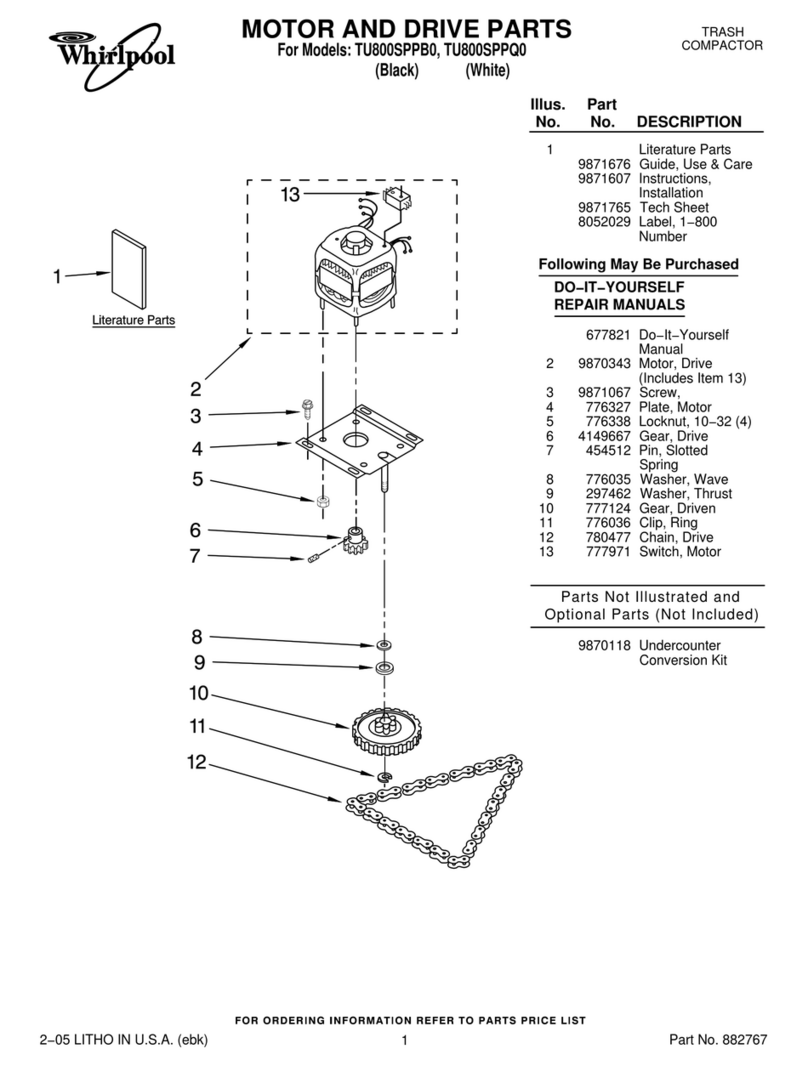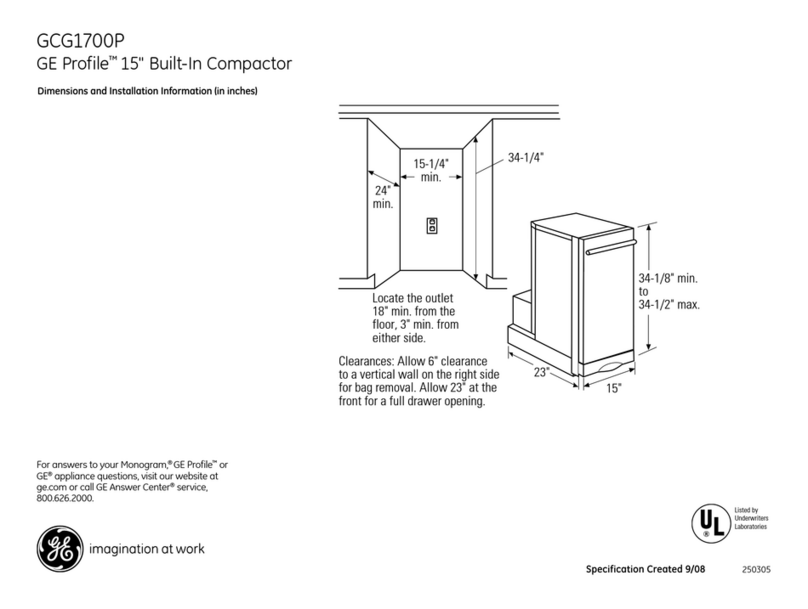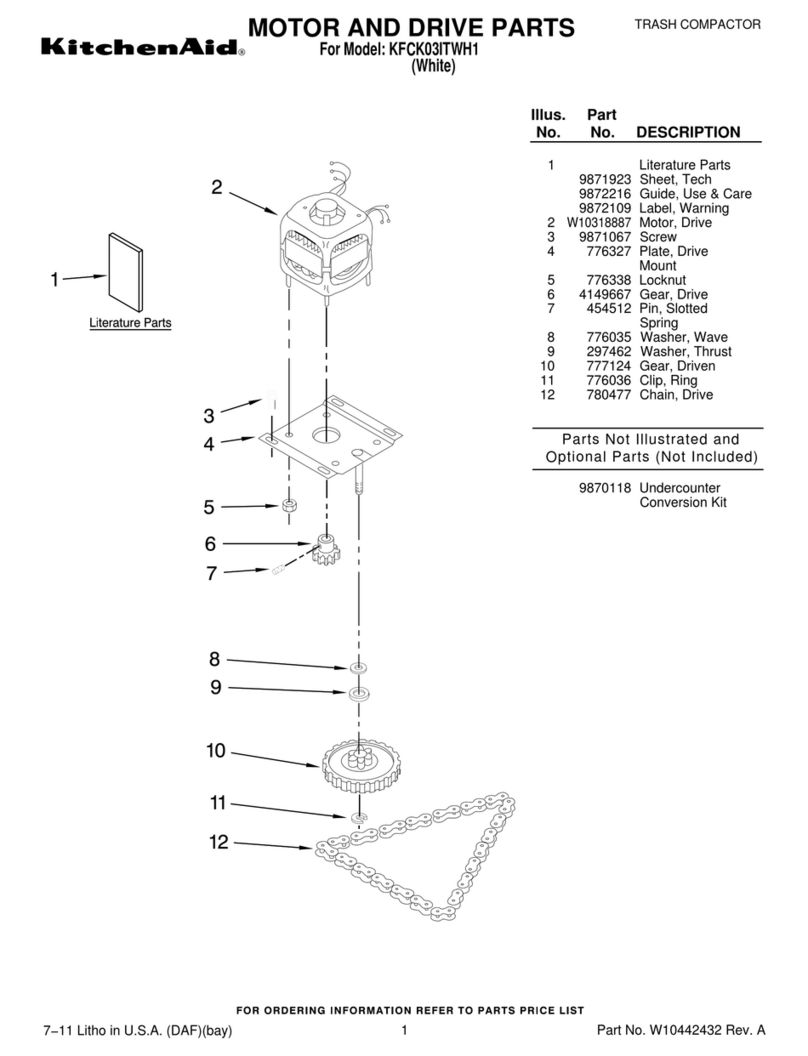PTR 420 User manual

2207 EAST ONTARIO STREET, PHILADELPHIA, PA. 19134
VERTICAL BALERS
FOR DEPENDABLE, COST-SAVING RECYCLING
ENGINEERED FOR SUPERIOR DURABILITY & MAXIMUM SAFETY
Model #_______________
Serial #_______________

TABLE OF CONTENTS
INTRODUCTION 3
GENERAL 4
WARRANTY 5
SAFETY/TRAINING INFORMATION 6-10
CONTROL LAYOUT 11
BALER OPERATING MODES 12
OPERATING INSTRUCTIONS 13-16
SAFE BALE EJECTION PROCEDURE 17-18
BALING WIRE IMFORMATION 19
PLC TROUBLESHOOTING 20-25
GENERAL TROUBLESHOOTING 26-30
LOCKOUT PROCEDURES 31-32
BALER MINIMUM CLEARANCE CHART 33
INSTALLATION INFORMATION 34-36
MAINTENANCE INSTRUCTIONS 37-40
ELECTRICAL INFORMATION 41-48
ELECTRICAL CIRCUITS 49-54
HYDRAULIC SCHEMATIC 55-56
PRESSURE SETTING & CHECKING PROCEDURES 57-58
BALER CYLINDER REPLACEMENT 59
DECAL & INSTRUCTION PLATES PLACEMENT 60
PARTS & SERVICE 61
WALL BRACKET KIT 62
MECHANICAL PARTS INFORMATION 63
LIMIT SWITCH INFORMATION 64
BALER PARTS DESCRIPTION & NUMBERS 65-67
Revised 10/2016

Congratulations on your purchase of a PTR Baler.
PTR is known for producing balers with the highest safety and quality standards
in the industry.
All PTR Balers are factory tested and receive a vigorous quality assurance
inspection to insure top performance and safety in the field.
Many of the advanced design features on our balers make operation easy
without sacrificing safety.
At PTR Baler and ompactor, operator safety is our number one priority. We
ask that all operators read and fully understand this manual and view the
provided safety/operational video. All baler operators must be at least 18 years
old.
UL Approved and UL Approved.
***IMPORTANT***
A. The operating keys are located inside of the control panel. A tool is
re uired to open the control box and only trained and authorized
service personnel should enter following proper lockout/tagout
procedures.
B. When power has been properly connected, press the Down/Up button
and observe the direction of the rotation of the motor. Look at the
motor fan, proper rotation is clockwise. (As indicated by arrow on
motor). If fan rotation is not clockwise, follow lock out/tag out
procedures and interchange any two of the three power conductors, re-
check for proper rotation. This should correct the problem.

GENERAL
PTR’s vertical downstroke baler is designed with the operator’s safety in mind.
However, as with most industrial equipment, the ultimate responsibility for
safety rests with the operator.
It is the operator’s duty to be thoroughly familiar with this manual and video
before operating the baler.
Additional operator responsibilities are to insure that the units’ operation is in
accordance with safety requirements and codes, especially all applicable
Occupational Safety and Health Administration (O.S.H.A) standards and
American National Standard Institute (A.N.S.I) Regulations.
PTR strongly recommends that current, completed, applicable ANSI and
OSHA standards are available to operators at all times.
PTR Baler and ompactor ompany strongly recommends: Keep the baler
clean and free of contaminant. Failure may cause illness or death. Bale clean
ardboard only.
Note:
The information contained herein is subject to change without notice.
We reserve the right to make changes, and alterations to the equipment
and information contained herein at anytime.

WARRANTY
PTR BALER AND COMPACTOR COMPANY warrants all equipment when operated,
maintained and installed, and used in normal service for a period of three hundred sixty-five
(365) days after the date of installation to be free from defects in material and workmanship
The responsibility of PTR BALER AND COMPACTOR COMPANY, under this warranty to the
purchaser, except as to title, shall not in any case exceed the cost of correcting defects in the
equipment Warranty repair or replacements shall not extend the initial warranty period
PTR BALER AND COMPACTOR COMPANY shall under no circumstances be responsible for
any loss of business or profit to the purchaser or any other consequential damages in connection
with the sale of such equipment or any obligation under this warranty The foregoing shall
constitute the sole remedy of the purchaser, and the responsibility of PTR BALER AND
COMPACTOR COMPANY
Warranty repairs and/or replacements (at our option), will be made for both parts and labor The
authorized service center must use PTR BALER AND COMPACTOR COMPANY authorized
parts Labor will be allowed at a maximum of ($40) hourly rate Premium rates will be at the
customer’s accountability All warranty calls must be called into PTR BALER AND
COMPACTOR COMPANY for dispatch 1-800-523-3645
All parts, components or accessories requiring repair or replacement, within the warranty period,
shall be returned PREPAID, to the PTR BALER AND COMPACTOR COMPANY at the
expense of the buyer, lessee, or consignee The PTR BALER AND COMPACTOR COMPANY
will return at its expense replacement parts, components or accessories found to be defective
Shipment of parts under warranty shall be made via United Parcel Service or Parcel Post Cost
of any other means or transportation shall be paid by the equipment user
PTR BALER AND COMPACTOR COMPANY does not assume any responsibility of liability
for improper use of the equipment or improper installation of any unit, part or accessory which
may cause damage to the unit The installation of parts or accessories manufactured or sold by
any other supplier shall be deemed to void all warranties
Warranty claims for equipment ill not be proceeded unless a properly completed and
signed arranty card (attached to the installation checklist) has been received.
NON-WARRANTABLE REPAIRS
1 Routine adjustments; limit switches, pressure switch, or relief valve
2 Tightening of hydraulic fittings and terminal connections
3 Electrical fuses, tripped over loads or breakers
4 Power to the unit, phase change, motor rotation change, facility electrical problems, or
damage by customer from improper electrical hook up to unit
5 Addition of hydraulic oil
6 Ejector system parts such as chains, t-hooks, and shackles
7 Repairs necessitated by improper use such as failure to follow instructions and abuse of
equipment
8 Operator error (example: chamber door not closed tight enough or gate not pulled down flush
to top of chamber door)
9 Damage or install errors from customer supplied installer
NOTE: Always have Serial and Model Number of unit ready when calling for service

Baler Safety and Training Outline
I. Scope - Employers should designate a Safety/Risk Manager or equivalent person that has
qualifications necessary to evaluate and manage safety and operational training issues related to the
operation of baling equipment as part of their operator safety and training program. Each individual
baler owner should develop their own training program specific to their equipment, personnel,
processes, environment, and unique site application.
A. Your company safety official should conducted a hazard assessment of the various
baling equipment utilized at your facility and use the information from the hazard
assessment to develop a company specific baler safety training program. The
hazard assessment should include at a minimum the following:
1) Identification of material being baled. (clean cardboard only)
2) Hazards associated with the baling equipment and material baled.
3) An initial and then periodic review of the capabilities, qualifications, and
training of any person who may potentially encounter the identified hazards.
B. Your company safety official should evaluated the means and methods of controlling the hazards
identified in the hazard assessment; including information such as industry and regulatory
requirements, instructions for the operation, inspection and maintenance of balers, and other
information appropriate to the identified hazards.
1) Your company safety official should ensure compliance with applicable OSHA Code of
Federal Regulations under 29 CFR 1910 and applicable ANSI baling equipment
standards under ANSI Z245.5 and Z245.51.
2) Your company safety official should ensure that all employees (including supervisors)
engaged in the operation, cleaning, maintenance, service, or repair of the baling
equipment are properly trained according to their assigned jobs or tasks. The Baler
Safety Video supplied by PTR should be shown to all potential operators and the
manual should be read thoroughly.
3) Contractors should not be permitted to operate in-house baling equipment unless they
have been properly trained and authorized.
C. As a leading baler manufacture we recommend that your company utilizes the following baler
safety training outline and baler safety video which cover the following:
1) Pre-start up
2) Operation –(operation procedures are also posted on front of control box)
3) Safe bale ejection
4) Inspection / maintenance (see baler safety inspection checklist included in this manual)
5) Operator Safety / Prohibited practices
6) Training requirements (necessary training as identified from hazard assessment and use
of baler safety video.
7) Record keeping –(see Attachment A)
D. Your company safety official should periodically review their company specific program to
ensure the effectiveness of your safety program and make revisions as necessary.

Heed & Obey Warning Signs
Signs such as Danger, Caution, Warning, and Attention are on the machine for your protection.
Warning signs must remain in place and be kept in readable condition. Report and replace all
damaged or missing warning signs.
Operational carelessness and safety shortcuts can cause serious injury or death! Follow safety
Guidelines and be safety conscious.
Every operator should read operators manual and the operating instructions posted on the front of the
control box.
The operating key should not be left in the machine when the machine is left unattended.
Prior to Start Up
1. Wear proper safety equipment as recommended by your company safety official.
2. Never allow yourself or anyone involved with the baling system to be under the influence intoxicants or
narcotics while the baler is operating.
3. Walk around the baling system to check for proper equipment condition. Open hopper door and check
inside the baler.
4. Be positive no one is working on the baler or adjoining equipment. With ram in up position, lift gate and
look inside main chamber area to be sure no one is inside.
5. The following operational check should be conducted prior to each shift:
·With the gate raised, press all buttons in any order or combination. No motion should occur.
·Close gate and start machine, open gate during downward motion. Machine should immediately
stop.
·Close gate and start machine. Gate will automatically open with upward ram travel. During this
time, raise the gate off the ram. Machine should immediately stop.
·Demonstrate that the machine will not operate in “automatic” if the main bale door is open.
Operator should do this by having the ram in the up position and with the gate closed set the selector
switch to down and push. Release the button and the ram should stop.
6. It is imperative that proper housekeeping is performed in the area behind and around the baler.
·The areas behind the baler must be kept clean and free of debris, pallets and any other material.
·PTR recommends that this area be inspected daily to maintain the safe operation of vertical
balers.
·Bale wire stored in the area of the baler must be stored in an approved horizontal storage system.
7. If anything does not function as indicated, immediately report
problems to supervisor, remove key, lockout machine, and call for
service.

Operator Safety
Always Use Lockout/Tagout
Power must always be disconnected and locked out before working within or performing maintenance
on the baler or associated equipment. Standard Lockout/Tagout procedures should be followed in
accordance with the OSHA standard 1910.147 “The control of hazardous energy”.
A group safety lock should be used when multiple employees are working on the machine at one time so
that all locks need to be removed in order to be able to re-energize the baler. Every employee who
works on or with the baler should have his own lock and key. Never assume you are protected by
another employee’s safety lock.
Keep Safety Guards in Place
Safety guards must be kept in place and secure at all times. Keep the guards in good repair with
periodic maintenance. Keep limit switches free of debris or obstructions. Do not override of
bypass safety switches or features.
If feed gate becomes difficult to open or close, maintenance should be informed.
Operators should be instructed on how to conduct a brief visual safety inspection that includes areas
door hinges and latch. Also how to conduct a visual inspection of the ejector chains, t-hooks, and
shackles. Operator should know that maintenance should be called if there is any evidence of
damage or if anything looks “different” as opposed to prior inspections.
Practice Fire Prevention
·Keep fire extinguishers accessible at all times. Use the extinguisher recommended for the
material being baled. It should be rated safe for use of electrical fires.
·Never smoke close to combustible material.
·Clean the area before welding or other repair activities that produce sparks or source of ignition.
·Keep tank and motor areas free of oil, dust, or paper accumulations.
Keep a Clean Machine
1. Bale only clean cardboard.
2. Clean motor area monthly.
3. Remove any wedged cardboard from sides and back of ram. Remove any cardboard on the top of the ram
daily.
4. Remove any cardboard stuck on retainer dogs and limit switches.
5. Keep baler clean and free of dirt and other contaminants. Failure to do so may cause illness or death.
6. The areas behind the baler must be kept clean and free of debris, pallets and any other material.
7. PTR recommends that the area behind the baler be inspected daily to maintain the safe operation of vertical
balers.
Remember! All possible Dangers cannot be predicted. Your own safety
attitude and habits are your best protection.

Additional Safety Guidelines for Baler Operation
1. Only authorized personnel 18 years of age or older, who are trained in baler operation are
permitted to operate the baler.
2. The owner and operator are responsible for the safety of the employees and should be familiar
with applicable OSHA and ANSI standards.
3. Operate in accordance with the owner’s manual supplied with your baler.
4. Do not set the hydraulic pressure above factory specs. Specified pressures are listed inside the
control box. Severe baler damage and/or personal injury could result.
5. Bale only the specified material for which the baler was built. And also for which the hazard
assessment was conducted for.
6. Never overload the baler chamber.
7. Never enter the main chamber area unless the power is disconnected and locked out.
8. If work on or in the baler is required, disconnect the power to the baler, and lockout. Never
assume that you are protected by another employee’s safety lock. Before restarting, repeat the
“Prior to Start Up” procedures.
9. Anytime the baler is shut down, the “Prior to Start up” procedures should be repeated.
10. Never bale aerosol cans or containers filled with liquid.
11. Use of safety glasses and forearm length leather gloves are strongly recommended when
handling baling wire.
12. The areas behind the baler must be kept clean and free of debris, pallets and any other material.
13. PTR recommends that the area behind the baler be inspected daily to maintain the safe
operation of vertical balers.
14. Bale wire stored in the area behind of the baler must be stored in an approved horizontal
storage system.

Attachment A
TRAINING RECORD
Employee Name
Description of Training and other Notes
Date of
Training
Seen Video
Yes/No
Employee Signature
Store name and location: ______________________ Training Video Present at Store: ____________________
Manual present at Store: __________________
Store #: _______
Name or Trainer: ____________________
Store Manager Name: _________________________ Signature of Trainer: ___________________
Signature and Date: ____________________________

1R 4XDQWLW\ 'HVFULSWLRQ 3DUW1XPEHU
)86(+2/'(5
352;6:,7&+)86(
)86(
975$16)250(5
5('/,*+7
*5((1/,*+7
7(50,1$/%/2&.6
(1'6(&7,216
.$%/2&.
.$%/2&.
83'2:1%87721
.(<6:,7&+
5(6(7%87721
&2//$5&217$&7
$29(5/2$'
$&217$&725
%5$66/8*
)86(%/2&.
3/&
386+38//%87721
:$775(6,6725
%2;'(&$/
61$3,13/8*
;%2;
$03)86(

BALER MODES
There are three basic modes of operation a downstroke vertical baler will perform
–loading, compression, and ejection.
LOADING
Material is evenly loaded into the baler chamber while the safety charging gate and
ram are in the UP position. The baler chamber door is closed and locked.
COMPRESSION
With the safety gate down, the ram pushes the material down into the bottom of the
baler chamber area. Retainer Dogs located on baler chamber door help hold the
compressed material down while the ram travels up to the loading position,
opening the baler safety charging gate as it travels up.
EJECTION
When full bale indicator arrows on the ram face and baler frame match, the bale is
the proper size. Lift gate, unlatch and open chamber door at least 110 degrees,
slide baling wire through slots and tie off all wires.
Close feed gate by pulling it down completely.
Attach the ejector “T” hooks at back of baler to ram ejector lugs, set the
UP/DOWN switch located on baler electrical box to the UP position, press and
hold button in until the bale ejects. Keep clear of ejecting bale.

5HYLVHG
3/&%DOHU
&RQWURO'HVFULSWLRQDQG
2SHUDWLQJ,QVWUXFWLRQV
7KLVXQLWLVWR HRSHUDWHG \DXWKRUL]HGDQGWUDLQHGSHUVRQQHORQO\%\ODZQRRQH
XQGHU\HDUVRIDJHLVSHUPLWWHGWRRSHUDWHWKLVPDFKLQH%DOHUPDQXDODQGVDIHW\
YLGHRPXVW HUHYLHZHGDVSDUWRIRSHUDWRUDQGPDLQWHQDQFHWUDLQLQJ
&21752/6$1',1',&$7256
7KH375%DOHUFRQWUROVZLWK3/&DUHQHDUO\LGHQWLFDOWRWKHVWDQGDUG DOHURSHUDWRUFRQWUROV
.H\HG212))6ZLWFK±7KHVZLWFKLVDQDFFHVVFRQWUROGHYLFHWKDWOLPLWVXVHWRDXWKRUL]HG
DQGWUDLQHGRSHUDWRUVLQSRVLWLRQRIWKHNH\$OVRDOORZVWKH DOHURSHUDWLRQWR HWXUQHGRIIIRU
URXWLQHSURGXFWLRQVXFKDVW\LQJRIID DOH.H\6ZLWFKLV127DORFNRXWWDJRXWGHYLFHDV
UHTXLUHGIRUVHUYLFHRUHQWU\LQWRWKHPDFKLQH
(6WRS±$OORZVWKHPDFKLQHWR HVWRSSHGDWDQ\WLPHLQFDVHRIHPHUJHQF\:LOOLOOXPLQDWH
ZKHQSUHVVHGDQGPXVW HPDQXDOO\SXOOHG DFNRXW HIRUHPDFKLQHFDQ HUHVWDUWHG
8S'RZQ6HOHFWD OH6WDUW±7KLVLVWKH XWWRQXVHGWRVWDUWWKHPDFKLQH7KHRXWHUULQJFDQ H
WXUQHGWRVHOHFW HWZHHQVWDUWXSDQGVWDUWGRZQ7KHPDFKLQHZLOORSHUDWHLQDXWRPDWLFPRGH
ZKHQWKHPDLQ DOHGRRULVVKXWWKHJDWHLVFORVHGDQGWKHUHLVOHVVWKDQDIXOO DOHLQWKH
FKDP HU1RWH3UHVVLQJWKHVWDUWEXWWRQZKLOHWKHUDPLVQRWLQWKHIXOO\UDLVHGSRVLWLRQ
ZLOOUHVXOWLQWKHUDPUHWUDFWLQJWRWKHIXOO\UDLVHGSRVLWLRQDQGVWRSSLQJ3UHVVLQJWKH
EXWWRQDJDLQZLOOUHVXOWLQDQRUPDOF\FOH
7KLV XWWRQZLOORSHUDWHDVDVXVWDLQHGPDQXDOSUHVVXUHFRQWUROWRDOORZIRU DOHHMHFWLRQZKHQ
WKHPDLQ DOHGRRULVRSHQRUZKHQWKHIXOO DOHOLJKWLVLOOXPLQDWHG7KHUDPPXVW HUXQXS
HIRUHLWFDQ HUXQGRZQZKHQLQPDQXDORSHUDWLRQLIWKHSUHVVXUHVZLWFKZDVDFWXDWHGGXULQJ
WKHSUHYLRXVGRZQVWURNH
5HVHW±7KLV XWWRQLVQRWQRUPDOO\XVHG:KHQSUHVVHGLWZLOOUHVHWWKHRYHUORDGLQWKH
XQOLNHO\HYHQWWKDWWKHRYHUORDGKDVWULSSHGDQGWKHRYHUORDGWULSSHGOLJKWLVLOOXPLQDWHG
3OHDVHFDOO375VHUYLFHLIWKHRYHUORDGKDVWULSSHGPRUHWKDQWKUHHWLPHVLQDQ\JLYHQRQH
PRQWKWLPHSHULRGDVWKLVFDQ HLQGLFDWLYHRIDQLPSURSHUPDFKLQHSRZHUFRQQHFWLRQRURWKHU
HOHFWULFDOIDXOW

5HYLVHG
)XOO305HTXLUHG*DWH)DXOW/LJKW±7KLVOLJKWZLOOLOOXPLQDWHDQGUHPDLQLOOXPLQDWHGLID
IXOO DOHLVGHWHFWHGLQWKH DOLQJFKDP HU$XWRPDWLFRSHUDWLRQZLOO HGLVD OHGDQGWKLVOLJKW
ZLOOUHPDLQLOOXPLQDWHGXQWLOWKH DOHLVWLHGRIIHMHFWHGIURPWKHPDFKLQHDQGWKHPDLQ DOH
GRRUFORVHG7KHPDFKLQHLVVWLOORSHUD OHLQPDQXDOPRGHZLWKWKHIXOO DOHOLJKWLOOXPLQDWHG
7KHIXOO DOHDUURZVZLOOOLQHXSZKHQWKHPD[LPXPVL]H DOHLVLQWKH DOHFKDP HU'RQRW
PDNH DOHV H\RQGWKHSRLQWZKHUHWKHDUURZVOLQHXS
7KHPDFKLQHKDV RWKDQLQWHUQDOF\FOHFRXQWHUDQGKRXUFRXQWHUWRWUDFNPDFKLQHXVDJH7KH
30OLJKWZLOOUHSHWLWLYHO\VORZ OLQNRQHVHFRQGRQIROORZHG \RQHVHFRQGRIIZKHQWKHF\FOH
FRXQWRUKRXUFRXQWH[FHHGVWKHSUHVHWYDOXHWKDWLQGLFDWHVSUHYHQWDWLYHPDLQWHQDQFHLV
UHTXLUHG&DOO375SDUWVDQGVHUYLFHWRVFKHGXOHSUHYHQWDWLYHPDLQWHQDQFH7KHPDFKLQHZLOO
FRQWLQXHWRRSHUDWHQRUPDOO\
7KLVLQGLFDWRUOLJKWZLOODOVRUHSHWLWLYHO\IDVW OLQNRQHKDOIVHFRQGRQIROORZHG \RQHKDOI
VHFRQGRIILIWKHLQWHUQDOSURJUDPGHWHFWVWKDWWKHJDWHSUR[LPLW\VZLWFKKDV HHQ \SDVVHGRULV
LQRSHUDWLYH2SHQLQJDQGUHVKXWWLQJWKHJDWHZLOOXVXDOO\FOHDUWKH OLQNLQJOLJKWDQGUHWXUQ
WKHPDFKLQHWRQRUPDORSHUDWLRQ3OHDVHFRQWDFW375SDUWVDQGVHUYLFHLIWKHOLJKWFRQWLQXHVWR
OLQNDQGWKHPDFKLQHUHPDLQVLQRSHUD OHDIWHURSHQLQJDQGFORVLQJWKHIHHGJDWH
*DWH6KXW/LJKW±7KLVOLJKWLQGLFDWHVWKDWWKHIHHGJDWHLVFRPSOHWHO\DQGSURSHUO\FORVHG7KH
QRUPDODXWRPDWLFF\FOHFDQQRW HVWDUWHGLIWKHJDWHLVQRWIXOO\FORVHG
'RRU6KXW/LJKW±7KLVOLJKWLQGLFDWHVWKDWWKHPDLQ DOHHMHFWGRRULVWLJKWO\FORVHGDVLV
UHTXLUHGIRUQRUPDODXWRPDWLFRSHUDWLRQ:LWKWKHGRRURSHQWKHPDFKLQHZLOORQO\UXQLQ
PDQXDOPRGHZLWKVXVWDLQHGPDQXDOSUHVVXUHFRQWURORSHUDWLRQDVQHFHVVDU\WRHMHFWWKH DOH
,IWKLVOLJKWLVQRWLOOXPLQDWHGILUVWWU\WLJKWHQLQJWKHORFNLQJKDQGZKHHOWRHQVXUHDFRPSOHWH
DQGWLJKWGRRUFORVXUH
2YHUORDG7ULSSHG/LJKW±7KLVOLJKWLQGLFDWHVWKDWWKHLQWHUQDOPRWRURYHUORDGKDVWULSSHG6HH
D RYHGHVFULSWLRQRIWKH5HVHWSXVK XWWRQ

5HYLVHG
%$/(523(5$7,1*,16758&7,216
$3UHSDULQJWKH DOHUWRPDNHDQHZ DOHRIFDUG RDUG
,QVXUHSRZHUNH\VZLWFKLVLQWKH2))SRVLWLRQ
,QVXUH DOHUUDPLVLQWKH83SRVLWLRQ
:LWKJDWHLQWKH83SRVLWLRQRSHQ DOHFKDP HUGRRU
/D\DIODWSLHFHRIFDUG RDUGRQWKH RWWRPRIWKH DOHFKDP HURYHUWRSRIWKHHMHFWRU
FKDLQV
&ORVHDQGODWFKWKH DOHFKDP HUGRRU
%7RPDNHD DOH
)LOOWKHFKDP HUZLWKFDUG RDUG R[HVQHHGQRW H URNHQGRZQWKHPDWHULDOWR H
DOHGVKRXOG HORDGHGHYHQO\LQWKHFKDP HU
3XOOWKHJDWHGRZQWRWKHWRSRIWKHFKDP HUGRRU
7XUQSRZHUNH\VZLWFKWRWKH213RVLWLRQ
6HWWKH83'2:1VZLWFKWRWKH'2:1SRVLWLRQZKLFKLVDOVRWKH$872VHWWLQJ
3UHVVWKH'2:1 XWWRQDQGUHOHDVHWKHUDPZLOOWUDYHOGRZQDQGDXWRPDWLFDOO\UHYHUVH
ZKHQUHDFKLQJIXOOGRZQVWURNH
5HSHDWD RYHVWHSVXQWLOWKHIXOO DOHOLJKWLOOXPLQDWHVRUXQWLOWKHDUURZVRQWKHIUDPH
DQGUDPDUHDOLJQHG
127(,IWKHJDWHLVRSHQHGDWDQ\WLPHGXULQJWKHF\FOHSULRUWRDXWRPDWLFDOO\RSHQLQJRULIOLIWHGRII
WKHUDPVZLWFKGXULQJDXWRPDWLFJDWHRSHQLQJ±WKHUDPZLOOLPPHGLDWHO\VWRS5DPZLOOUHWUDFWWR
WKHIXOOXSSRVLWLRQRQUHVWDUWUHJDUGOHVVRIVHWWLQJRQ8S'RZQVHOHFWRU
&7RWLHRIIDQGHMHFWD DOH1RWH6WHSVWKUXDUHRSWLRQDOWRDOORZWKHDGGLWLRQRIDWRSIODW
VKHHWIRUHDVLHUW\LQJRIWKH DOH
7XUQWKH83'2:1VZLWFKWRWKH83SRVLWLRQ
3UHVVDQGKROGWKH83 XWWRQWRUDLVHWKHUDP
7XUQWKHNH\VZLWFKWRWKH2))SRVLWLRQ
/D\DIODWSLHFHRIFDUG RDUGRQWRSRIWKH DOHWRSURYLGHDIODWVXUIDFHIRUHDVLHUW\LQJ
RIWKH DOH±'2127UHDFKLQWRWKHFKDP HU
/RZHUWKHJDWHDQGWXUQWKHNH\VZLWFKWRWKH21SRVLWLRQ
7XUQWKH83'2:1VZLWFKWRWKH'2:1SRVLWLRQ
3UHVVDQGKROGWKH'2:1 XWWRQWLOOWKHUDPVWRSVDJDLQVWWKHIXOO DOH
7XUQWKHNH\VZLWFKRIIDQGUHPRYHWKHNH\
/LIWJDWHXQODWFKDQGRSHQFKDP HUGRRUDWOHDVWGHJUHHV'RQRWVWDQGLQIURQWRI
WKHGRRU
6OLGH DOLQJZLUHWKURXJKVORWVLQIORRUDQG DFNWKURXJKVORWVLQUDP7KH³SRNHUURG´
RUFDUG RDUGFOHDULQJWRROFDQ HXVHGLIQHFHVVDU\WRFOHDUDSDVVDJHIRUWKH DLOLQJ
ZLUH
7LHRIIDOOZLUHV
3RVLWLRQDSDOOHWKDQGWUXFNIRUNOLIWLQIURQWRI DOHURSHQLQJWRUHFHLYHWKH DOHZKHQ
LW¶VHMHFWLQJ

5HYLVHG
3ODFHHMHFWRUKRRNVRQWRWKHHMHFWRUUDPOXJVLQWKH DFNRIWKH DOHU
,QVHUWWKHNH\DQGWXUQWKHVZLWFK216HWWKH83'2:1VZLWFKWRWKH83SRVLWLRQ
3XOOJDWHGRZQXQWLOLWLVRQWKHUDPJDWHVZLWFKLIWKHUDPLVVWRSSHGKLJKHUWKDQWKH
GRRURUFORVHGFRPSOHWHO\LIWKHUDPLV HORZWKHGRRU
.HHSLQJWKHDUHDLQIURQWRIWKHPDFKLQHFOHDURIDOOSHUVRQQHO3UHVVDQGKROGWKH83
VZLWFKXQWLOWKH DOHHMHFWV
3XOOJDWHGRZQFRPSOHWHO\
7XUQWKH83'2:1VZLWFKWRWKH'2:1SRVLWLRQ
3UHVVWKH'2:1 XWWRQDQGKROGHMHFWRUFKDLQVDQGKRRNVZLOODXWRPDWLFDOO\
GLVHQJDJHGXULQJGRZQZDUGWUDYHO
7XUQWKH83'2:1VZLWFKWRWKH83SRVLWLRQ
3UHVVWKH83'2:1 XWWRQDQGKROGGRZQXQWLOWKHUDPLVLQWKH83SRVLWLRQ
7XUQWKHNH\VZLWFK2))/D\DIODWSLHFHRIFDUG RDUGRQWKH RWWRPRIWKH DOH
FKDP HURYHUWRSRIWKHHMHFWRUFKDLQV
&ORVHDQGODWFKWKH DOHFKDP HUGRRU
' 5HDG\IRUDQHZ DOHRIFDUG RDUG
)ROORZVWHSV$%&
x127
D2FFDVLRQDOO\FDUG RDUGZLOO HZHGJHGLQWKHUDPDUHD
7XUQRIIWKHSRZHUDWWKHGLVFRQQHFW R[DQGUHPRYHDQ\H[FHVVFDUG RDUGLIOHIWWR
XLOGXSLWFRXOGDIIHFWWKHRSHUDWLRQRIWKH DOHU
,IDQRSHUDWRUZLOOWU\VWRUXQWKH DOHUDQGLWGRHVQRWRSHUDWH
%HVXUHWKHSRZHUNH\VZLWFKLV21
%HVXUHJDWHLVSXOOHGGRZQFRPSOHWHO\DQGJDWHFORVHGOLJKWLVLOOXPLQDWHG
%HVXUHFKDP HUGRRULVFRPSOHWHO\FORVHGDQGGRRUFORVHGOLJKWLVLOOXPLQDWHG
%HVXUHQRWWROLIWWKHJDWHZKLOHUDPLVPRYLQJ DOHUZLOOVKXWGRZQDQGQRWVWDUWXQWLO
JDWHLVSXOOHGGRZQWRWKHWRSRIWKHFKDP HUGRRU

!""#
#
$%&%&#'"(%%%%
#)*"&#
+&",-,%--,##!""
&#"&%#
)%."&&%(%-%%#
%&(& !%&(%#
%-&%%"%%"&#/&
#
(%%%%(%
%&(%#0,,#%
%%%(#
%%"%%%
%(%&&%%%"#
1#%%(-2&%#
#"(%#
#%%-%&#
3#$%&%&("%"%
%(#
4#%%(-2&%#
5#6"#7-&%8#
6"&%",%-#
9#):-;%%"&%(%#
=%%&"((%""&#"%,
%(>
(>&%%""&#'"%"
"%%"(&&%%""&#
?#/%%%,%"&:;%%"%%
(&%%%&"%%"%%%
%#7%&%%(%#%&
%-"%&%&
%(8#

6#&%&%%(&"%:;#!%
&,%&%%"%"&%%%#!
"&%"%%&%%#!&"&
"&%%%"&#
1#/%%,-%&%:;(%%"%%(&
%%:;&"%%&%%
%#&%>"&(%#
11#@--%%%#
1#%:;%&%-&%
%&%%&&"%#
1#%:;%&%"%%"&#
13#A%&""%#
14#&%&%%"%%%%&(
:;%#
15#A(%%""%%:%-;%-#
19#%%-#
1?# '&%%%""#+%%
""&%%#!&%"&%#"
&%%"&%&""#
16#%%%%6
"%#
#%%#
1#(%%%#
#%&%"#
#%&""%%:%-;%-#
3#%--(%#
4#"%%"&#%
"&"%(%#

PTR Baler & Compactor Co.
2207 E. Ontario St Philadelphia, PA 19134
PHONE: 215-533-5100 * FAX 215-533-8907
Quality * History * Service* Value
Baling wire recommendation for PTR Baler and Compactor Company’s
standard built balers producing bales of ordinary cardboard. Consult
PTR Baler and Compactor for wire recommendations for non-cardboard
applications.
MODELS: 1800HD, 2318, 2300HD, 3400HD, 3600HD, 7230
Minimum of 14 Ga galvanized steel wire approximately 14’ long with one end looped for bale
tie off.
Wire is to have a tensile strength of approximately 70,000 to 85,000 psi or more and a break
strength of approximately 380 to 420 pounds or more.
MODELS: 360, 420
Minimum of 15 Ga galvanized steel wire approximately 9’ long with one end looped for bale tie
off.
Wire is to have a tensile strength of approximately 75,000 to 80,952 psi or more and a break
strength of approximately 300 to 340 pounds or more.
MODELS: 5000HD, 7200HD
Minimum of 12 Ga galvanized steel wire approximately 16’ long with one end looped for bale
tie off.
Wire is to have a tensile strength of approximately 70,588 to 76,136 psi or more and a break
strength of approximately 600 to 670 pounds or more.
Additional Information:
At least four baling wires must be used per bale. Slots are available for five or more bailing
wires to be used.
Care should be exercised when handling any potentially sharp objects such as bailing wire.
Follow appropriate precautions and procedures.
Always stand clear of ejecting bale.
Baling wire recommendation is based on industry standard and past history of success with this
wire in a wide variety of customer environments and usages of balers and other vertical balers
with comparable compression yielding bales of comparable size and weight.

5HYLVHG
0DQDJHUDQG6WRUH0DLQWHQDQFH,QVWUXFWLRQV
7KLVXQLWLVWR HRSHUDWHGDQGPDLQWDLQHG \DXWKRUL]HGDQGWUDLQHGSHUVRQQHORQO\1R
RQHXQGHU\HDUVRIDJHLVSHUPLWWHGWRRSHUDWHRUVHUYLFHWKLVPDFKLQH6WDQGDUG
DOHUPDQXDODQGVDIHW\YLGHRPXVW HUHYLHZHGDVSDUWRIRSHUDWRUDQGPDLQWHQDQFH
WUDLQLQJ2QO\TXDOLILHGWUDLQHGDQGDXWKRUL]HGSHUVRQQHOFDQSHUIRUPWKHVHDFWLRQVDV
WKHFRQWUROSDQHOPXVW HRSHQHGWRDFFHVVWKH3/&6DIHZRUNSUDFWLFHVLQDFFRUGDQFH
ZLWK1)3$(PXVW HIROORZHGZKHQDFFHVVLQJDOLYHHOHFWULFDOSDQHO
7528%/(6+227,1*±%DVLF$XWKRUL]HGSHUVRQQHORQO\
0DFKLQHZLOOQRWUXQDQG(VWRSSUHVVHGOLJKWLVLOOXPLQDWHG3XOORXWHVWRS
0DFKLQHZLOOQRWUXQDQGRYHUORDGWULSSHGOLJKWLVLOOXPLQDWHG3UHVVWKHUHVHW XWWRQDQGFDOO375
VHUYLFH
0DFKLQHZLOOQRWUXQDQGIXOO30UHTXLUHGJDWHIDXOWOLJKWLV OLQNLQJRSHQDQGUHVKXWWKHIHHG
JDWH,IWKLVVWLOOGRHVQRWUHVROYHWKHLVVXHFDOOIRUVHUYLFHRUIROORZWKHWURX OHVKRRWLQJJXLGHIRU
DXWKRUL]HGSHUVRQQHORQO\±6HHQH[WVHFWLRQ
0DFKLQHZLOORQO\UXQZLWKVXVWDLQHGPDQXDOSUHVVXUHFRQWUROVDQGIXOO DOHOLJKWLVLOOXPLQDWHG2SHQ
PDLQGRRUWLHRII DOHHMHFW DOHDQGUHFORVHPDLQGRRU
0DFKLQHZLOORQO\UXQZLWKVXVWDLQHGPDQXDOSUHVVXUHFRQWUROVDQGGRRUVKXWOLJKWLVQRWLOOXPLQDWHG
6KXWPDLQ DOHGRRUDQGWLJKWHQVLGHZKHHOORFN
0DFKLQHLVRSHUDWLRQDO XWIXOO30UHTXLUHGJDWHIDXOWOLJKWLV OLQNLQJ0DFKLQHLVGXHIRU
SUHYHQWDWLYHPDLQWHQDQFH&DOOVHUYLFHIRU300DFKLQHFDQFRQWLQXHWR HRSHUDWHGQRUPDOO\
This manual suits for next models
7
Table of contents
Popular Trash Compactor manuals by other brands

SUMMIT EQUIPMENT
SUMMIT EQUIPMENT SC-3248 Safety, operation & maintenance manual
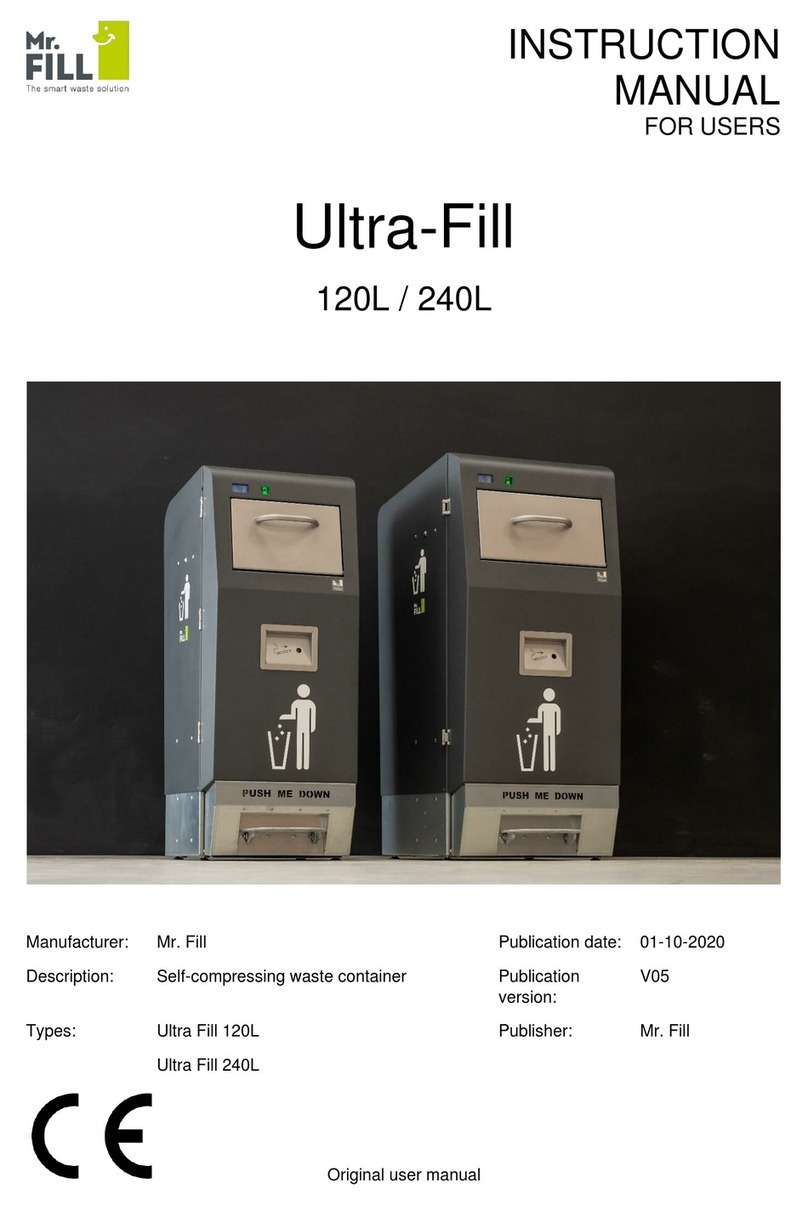
Mr. FILL
Mr. FILL Ultra Fill 120L instruction manual
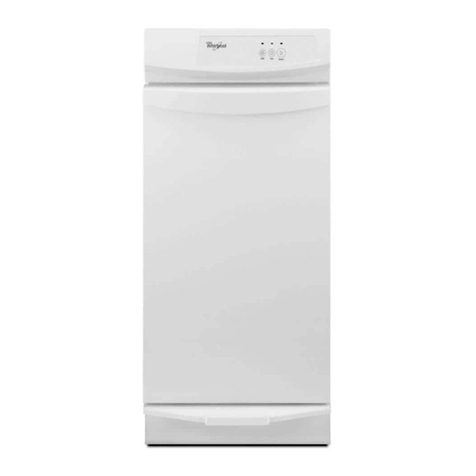
Whirlpool
Whirlpool GC900QPPQ User instructions
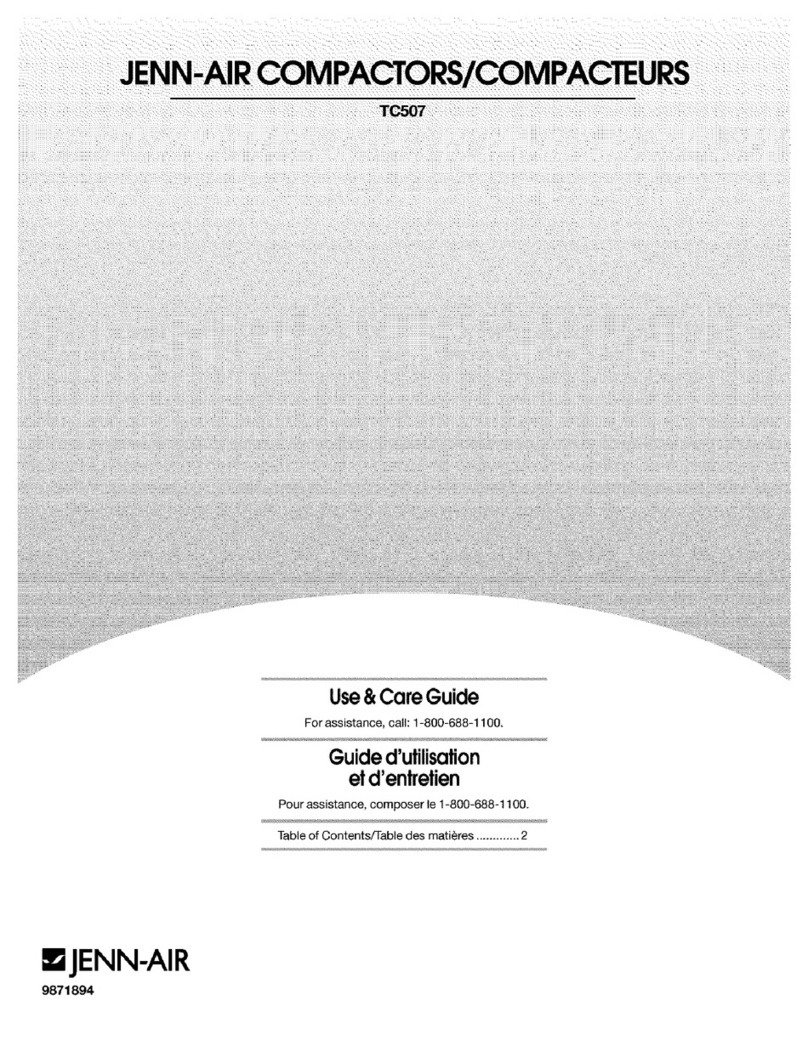
Jenn-Air
Jenn-Air TC507 Use & care guide

LDI
LDI SAFCO 9922 Assembly instructions
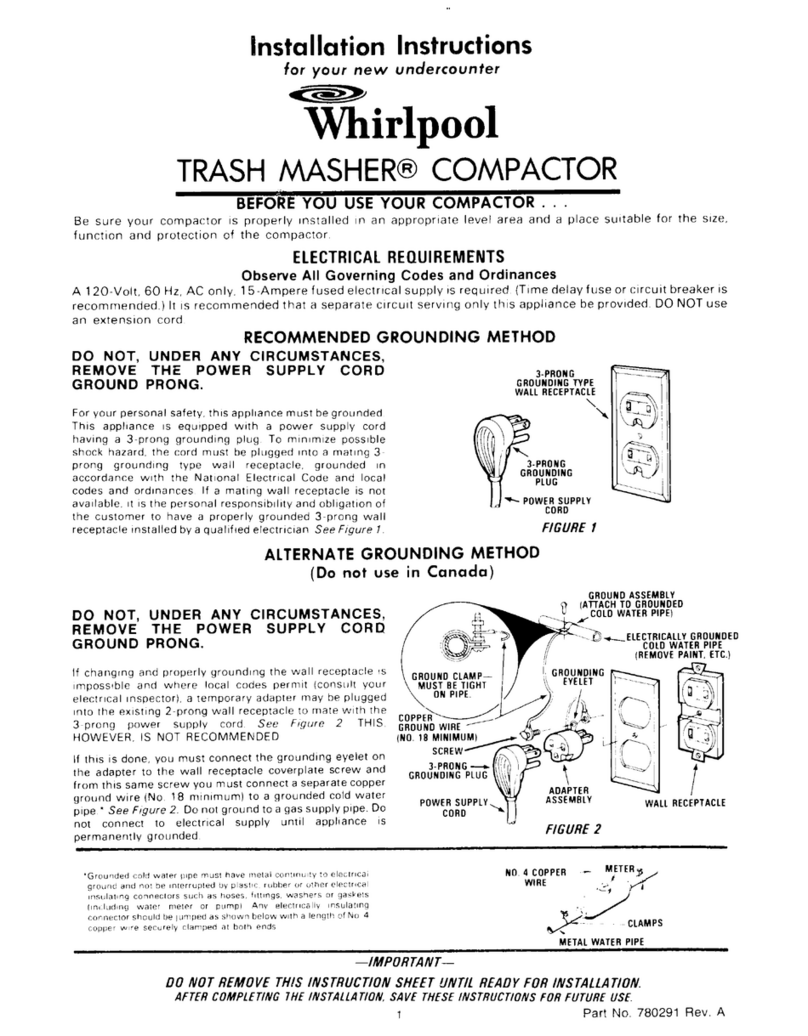
Whirlpool
Whirlpool Trash Masher installation instructions
